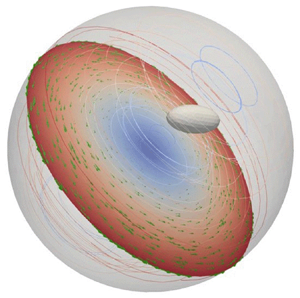Article contents
Single-particle dynamics in a low-Reynolds-number fluid under spherical confinement
Published online by Cambridge University Press: 14 August 2023
Abstract

Non-colloidal dynamics of a single particle suspended in a low-Reynolds-number fluid under spherical confinement was studied numerically. We calculated hydrodynamic mobilities of a sphere, a prolate spheroid and an oblate spheroid parallel and transverse to the particle-cavity line of centres. The mobilities show maximum in the cavity centre and decay as the particle moves towards the no-slip wall. For prolate and oblate spheroids, their mobilities are also affected by the angle between the particle's axis of revolution and the particle-cavity line of centres due to particle anisotropy. It was observed that the effect of particle anisotropy becomes stronger as the confinement level increases. When the external force on the particle is not parallel or transverse to the particle-cavity line of centres, a drift velocity perpendicular to the force occurs because of the confinement-induced anisotropy of the mobility in the cavity. The normalized drift velocity depends on the particle location, size, shape and orientation of the non-spherical particle. We also studied the motion of a non-neutrally buoyant particle under external forces in a rotating flow inside the cavity. Cooperation between the external force, rotation-induced centrifugal or centripetal force and the force from particle–wall interactions leads to multiple modes of particle motion. A fundamental understanding of single-particle dynamics in this work forms the basis for studying more complex particle dynamics in intracellular transport, and can guide particle manipulation in microfluidic applications ranging from droplet-based microreactors to microfluidic encapsulation.
Information
- Type
- JFM Papers
- Information
- Copyright
- © The Author(s), 2023. Published by Cambridge University Press
References
Chen and Jiang Movie 1
Chen and Jiang Movie 2
Chen and Jiang Movie 3
Motion of spherical particle under the centrifugal force, which corresponds to Fig. 11.
Chen and Jiang Movie 4
Motion of spherical particle under the centrifugal force, which corresponds to Fig. 12a and Fig. 12b.
Chen and Jiang Movie 5
Motion of spherical particle under the centrifugal force, which corresponds to Fig. 12c and Fig. 12d.
Chen and Jiang Movie 6
Motion of prolate spheroid under the centrifugal force, which corresponds to Fig. 13b.
Chen and Jiang Movie 7
Motion of prolate spheroid under the centrifugal force, which corresponds to Fig. 13d.
Chen and Jiang Movie 8
Motion of oblate spheroid under the centrifugal force, which corresponds to Fig. 13e.
- 4
- Cited by


